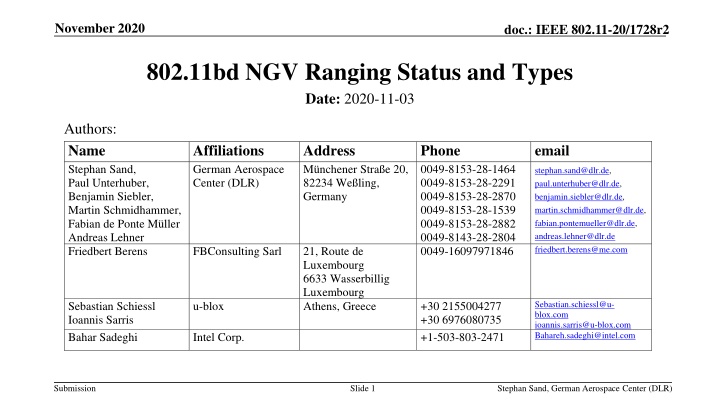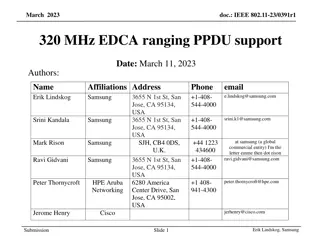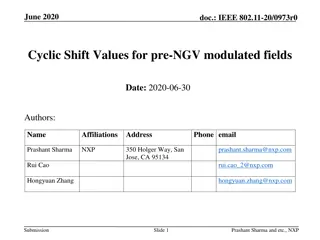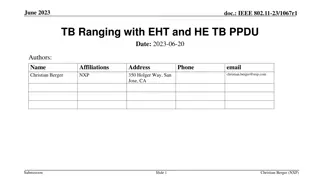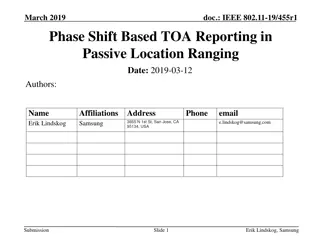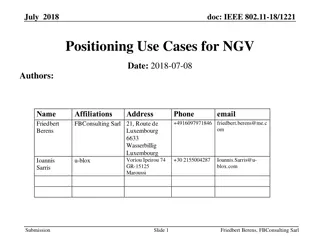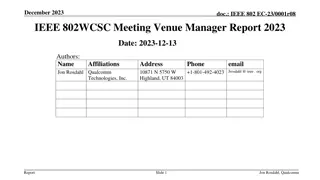IEEE 802.11-20/1728r2 NGV Ranging Contributions
Review of contributions on ranging for IEEE 802.11bd NGV, highlighting different ranging types and protocols discussed. Various use cases, performance results, and considerations on ranging methods for NGV are explored in the document.
Download Presentation

Please find below an Image/Link to download the presentation.
The content on the website is provided AS IS for your information and personal use only. It may not be sold, licensed, or shared on other websites without obtaining consent from the author.If you encounter any issues during the download, it is possible that the publisher has removed the file from their server.
You are allowed to download the files provided on this website for personal or commercial use, subject to the condition that they are used lawfully. All files are the property of their respective owners.
The content on the website is provided AS IS for your information and personal use only. It may not be sold, licensed, or shared on other websites without obtaining consent from the author.
E N D
Presentation Transcript
November 2020 doc.: IEEE 802.11-20/1728r2 802.11bd NGV Ranging Status and Types Date: 2020-11-03 Authors: Name Stephan Sand, Paul Unterhuber, Benjamin Siebler, Martin Schmidhammer, Fabian de Ponte M ller Andreas Lehner Friedbert Berens Affiliations German Aerospace Center (DLR) Address M nchener Stra e 20, 82234 We ling, Germany Phone 0049-8153-28-1464 0049-8153-28-2291 0049-8153-28-2870 0049-8153-28-1539 0049-8153-28-2882 0049-8143-28-2804 0049-16097971846 email stephan.sand@dlr.de, paul.unterhuber@dlr.de, benjamin.siebler@dlr.de, martin.schmidhammer@dlr.de, fabian.pontemueller@dlr.de, andreas.lehner@dlr.de friedbert.berens@me.com FBConsulting Sarl 21, Route de Luxembourg 6633 Wasserbillig Luxembourg Athens, Greece Sebastian.schiessl@u- blox.com ioannis.sarris@u-blox.com Bahareh.sadeghi@intel.com Sebastian Schiessl Ioannis Sarris Bahar Sadeghi u-blox +30 2155004277 +30 6976080735 +1-503-803-2471 Intel Corp. Submission Slide 1 Stephan Sand, German Aerospace Center (DLR)
November 2020 doc.: IEEE 802.11-20/1728r2 Abstract We review contributions on ranging for 802.11bd NGV and summarize the different ranging types. This leads to straw polls asking: What preferences does the group have on the different ranging types? Submission Slide 2 Stephan Sand, German Aerospace Center (DLR)
November 2020 doc.: IEEE 802.11-20/1728r2 802.11bd NGV Documents Addressing Ranging PAR/FRD [1], [2]: amendment defines procedures for at least one form of positioning in conjunction with V2X communications UC Doc [3]: UC5 Vehicular Positioning & Location, UC8 Train-to-Train, UC9 Vehicle-to-Train SFD [4]: 11bd supports round-trip-time (RTT) ranging for 10 MHz and 20 MHz bandwidth PPDUs. Draft 0.4: An NGV PHY shall support the following features: Round trip time (RTT) based ranging using 10 and 20 MHz bandwidth PPDUs Submission Slide 3 Stephan Sand, German Aerospace Center (DLR)
November 2020 doc.: IEEE 802.11-20/1728r2 802.11bd NGV Contributions Addressing Ranging Positioning Use Cases for NGV [5] NGV Ranging Discussions [6]: FTM, NTB, TB, and passive TB ranging Ranging Performance in 11bd [7] : Performance results NTB ranging Considerations on Ranging in NGV [8]: Performance results one-way TOF & RTT ranging, 60 GHz On ranging methods for NGV [9]: First comparison one-way TOF, two- way RTT, FTM EDCA, and NTB ranging Ranging Protocol in 11bd [10]: Ranging advertisement & NTB ranging Influence of Delay-Close Multi Path Components on FTM-RTT [11]: Performance results RTT ranging Submission Slide 4 Stephan Sand, German Aerospace Center (DLR)
November 2020 doc.: IEEE 802.11-20/1728r2 Passive TOF/RTT/ FTM EDCA /NTB Ranging type One-Way TOF [8,9] Two-way RTT [8,9,11] FTM EDCA [6,9,11] NTB [6,7, 9,10] TB [6] Passive TB [6] - - 802.11-2016 802.11az - 802.11az 802.11az Standard Challenges accurate absolute timing at each STA; TOD (sub ns accuracy) & TX location included in measurement frame TODs (sub ns accuracy) & TX location included in measurement frame and/or fixed timing for reply ACK high channel load ( 6 frames), 30 ms 100 ms position (no parallel ex- change) 1 request + ACK frame, 5 frames in one TXOP, 0.6 ms, 2 ms position additional measurement reports depending on ranging type 9-11 frames in one TXOP, AP based, spatial streams UL and DL, not OCB 15 frames in one TXOP, based on TB 1 2 6-7 1-2 add. meas. report 9-11 Transmitted frames Security/ Privacy 11bd Changes 6 15 - - - optionally depending on type optionally No strict timing synchronization, TOD in measure- ment frame TOD in measurement frame, exchange in one TXOP None, optional: reduce frames, parallel ranging ex-change NDPA/NDP frame using NGV PPDU depending on type adaptation to OCB Only with TB, adaptation to OCB Submission Slide 5 Stephan Sand, German Aerospace Center (DLR)
November 2020 doc.: IEEE 802.11-20/1728r2 Passive two- way RTT/ FTM EDCA /NTB Ranging type One-Way TOF [8,9] Two-way RTT [8,9,11] FTM EDCA [6,9,11] NTB [6,7, 9,10] TB [6] Passive TB [6] - - 802.11-2016 802.11az - 802.11az 802.11az Standard Challenges accurate absolute timing at each STA; TOD (sub ns accuracy) & TX location included in measurement frame TODs (sub ns accuracy) & TX location included in measurement frame and/or fixed timing for reply ACK high channel load ( 6 frames), 30 ms 100 ms position (no parallel ex- change) 1 request + ACK frame, 5 frames in one TXOP, 0.6 ms, 2 ms position additional measurement reports depending on ranging type 9-11 frames in one TXOP, AP based, spatial streams UL and DL, not OCB 15 frames in one TXOP, based on TB 1 2 6-7 1-2 add. meas. report 9-11 Transmitted frames Security/ Privacy 11bd Changes 6 15 Not feasible time sync optionally OCB requires significant rework - - - optionally depending on type No strict timing synchronization, TOD in measure- ment frame TOD in measurement frame, exchange in one TXOP None, optional: reduce frames, parallel ranging ex-change NDPA/NDP frame using NGV PPDU depending on type adaptation to OCB Only with TB, adaptation to OCB Submission Slide 6 Stephan Sand, German Aerospace Center (DLR)
November 2020 doc.: IEEE 802.11-20/1728r2 Passive FTM EDCA /NTB Ranging type One-Way TOF [8,9] Two-way RTT [8,9,11] FTM EDCA [6,9,11] NTB [6,7, 9,10] TB [6] Passive TB [6] - - 802.11-2016 802.11az - 802.11az 802.11az Standard Challenges accurate absolute timing at each STA; TOD (sub ns accuracy) & TX location included in measurement frame TODs (sub ns accuracy) & TX location included in measurement frame and/or fixed timing for reply ACK high channel load ( 6 frames), 30 ms 100 ms position (no parallel ex- change) 1 request + ACK frame, 5 frames in one TXOP, 0.6 ms, 2 ms position additional measurement reports depending on ranging type 9-11 frames in one TXOP, AP based, spatial streams UL and DL, not OCB 15 frames in one TXOP, based on TB 1 2 6-7 1-2 add. meas. report 9-11 Transmitted frames Security/ Privacy 11bd Changes 6 15 Feasibility not tested Not feasible time sync optionally OCB requires significant rework - - - optionally depending on type No strict timing synchronization, TOD in measure- ment frame TOD in measurement frame, exchange in one TXOP None, optional: reduce frames, parallel ranging ex-change NDPA/NDP frame using NGV PPDU depending on type adaptation to OCB Only with TB, adaptation to OCB Submission Slide 7 Stephan Sand, German Aerospace Center (DLR)
November 2020 doc.: IEEE 802.11-20/1728r2 Ranging type FTM EDCA [6,9,11] NTB [6,7, 9,10] Highly dynamic V2X environment: latency critical High channel load: DCC may delay next TXOP by 1 second [12] FTM EDCA: 3 separate frames with ACKs FTM measurement exchange including LMRs several seconds High latency 802.11-2016 802.11az Standard Challenges Highly dynamic V2X environment: latency critical High channel load: DCC may delay next TXOP by 1 second [12] NTB measurement exchange including LMRs in one TXOP only 0.6 ms Low latency high channel load ( 6 frames), 30 ms 100 ms position (no parallel ex- change) 1 request + ACK frame, 5 frames in one TXOP, 0.6 ms, 2 ms position 6-7 Transmitted frames Security/ Privacy 11bd Changes 6 - optionally Support for authentication, integrity check, and privacy of ranging message None, optional: reduce frames, parallel ranging ex-change NDPA/NDP frame using NGV PPDU Submission Slide 8 Stephan Sand, German Aerospace Center (DLR)
November 2020 doc.: IEEE 802.11-20/1728r2 Passive Ranging 11az defines passive TB ranging: Relative range (TDOA) of arbitrary number of passive STAs (PSTAs) No additional measurement exchanges needed In addition to LMR reports two RSTA broadcast passive TB ranging measurement report frames Scalability Submission Slide 9 Stephan Sand, German Aerospace Center (DLR)
November 2020 doc.: IEEE 802.11-20/1728r2 Passive Ranging Proposal Passive NTB ranging: Relative range (TDOA) of arbitrary number of passive STAs (PSTAs) No additional measurement exchanges needed In addition to LMR reports two report frames e.g. LCI or R/ISTA broadcast passive ranging measurement Scalability NDP Announcement Submission Slide 10 Stephan Sand, German Aerospace Center (DLR)
November 2020 doc.: IEEE 802.11-20/1728r2 Multi-channel 11az Ranging [13] Leveraging higher layer (1609/ITS-G5) multi-channel operation Capability discovery handled via higher layer mechanisms through 11bd Flexible and low-overhead application of 11az in 11bd and OCB mode Ranging can occur through multi-channel operation inside 5.9 GHz ITS band: NTB ranging (NGV NDP/NDPA and LMR frames) 802.11 security using 11az pre-association security negotiation (PASN) outside 5.9 GHz ITS band Enables use of higher BW channels for higher accuracy ranging where applicable Use of 11az PHY security and different 11az ranging options possible Minimal changes/spec work required in 11bd Submission Slide 11 Stephan Sand, German Aerospace Center (DLR)
November 2020 doc.: IEEE 802.11-20/1728r2 Mandatory vs. Optional Ranging Types Optional ranging types Need for advertisement and negotiation Higher flexibility for different applications Mandatory ranging type(s) All NGV devices possible I/RSTA No need for advertisement and negotiation E.g. NTB ranging advertisement unnecessary Mandatory capture of accurate TOA/TOD of frames E.g. FTM EDCA Ranging FTM Request unnecessary Faster ranging and positioning Submission Slide 12 Stephan Sand, German Aerospace Center (DLR)
November 2020 doc.: IEEE 802.11-20/1728r2 Conclusions 11bd NGV ranging: Two out of five ranging types plus passive methods One-way TOF: time synchronization and fast time stamp Two-way RTT: fast time stamp and fixed timing for ACK (processing time) FTM EDCA: easily adapted for 11bd, 3 separate frames + ACK high latency NTB: define additional frames, one TXOP measurement exchange and reporting low latency Passive NTB(/FTM EDCA): In addition to LMR reports two LCI reports scalability TB and passive TB: Significant changes to work OCB Multi-channel 11az ranging: 11bd STAs negotiate 11az ranging outside 5.9 GHz band Mandatory vs. optional ranging type(s): Flexibility Reduced channel use Faster ranging and positioning Submission Slide 13 Stephan Sand, German Aerospace Center (DLR)
November 2020 doc.: IEEE 802.11-20/1728r2 References [8] Considerations on Ranging in NGV 11-19- 0788r3 [9] On ranging methods for NGV 11-19-1892r0 [10] Ranging Protocol in 11bd 11-19-2011r0 [11] Influence of Delay-close Multi Path Components on FTM-RTT 11-19-1929r1 [12] ETSI EN 302 571 V2.1.1 (2017-02), ITS; Radiocommunications equipment operating in the 5 855 MHz to 5 925 MHz frequency band [13] Ranging in 11bd 11-20/1761r2 [1] Project Authorization Request (PAR) 11-18- 0861r9 [2] TGbd Functional Requirements Document (FRD) 11-19-0495r3 [3] TGbd Use Case Document 11-19-1342r1 [4] TGbd Spec Framework Document (SFD) 11- 19-11-19-0497r7 [5] Location use cases for NGV 11-18-1221r0 [6] NGV ranging discussion 11-18-1250r0 [7] Ranging Performance in 11bd 11-19-0859r0 Submission Slide 14 Stephan Sand, German Aerospace Center (DLR)
November 2020 doc.: IEEE 802.11-20/1728r2 SP #1 Do you agree to add in the SFD 11bd supports distance measurement using NTB ranging for 10 MHz and 20 MHz bandwidth PPDUs in the 5.9 GHz band. This feature is optional. Yes/No/Abstain/No Vote: 21/0/5/26 Motion passe by unanimous consent Yes/No/Abstain/No Vote: /// Submission Slide 15 Stephan Sand, German Aerospace Center (DLR)
November 2020 doc.: IEEE 802.11-20/1728r2 SP #2 Do you agree to add to the SFD 11bd supports hyperbolic positioning using differential time of arrival for 10 MHz and 20 MHz bandwidth PPDUs in the 5.9 GHz band. This feature is optional. Yes/No/Abstain: Submission Slide 16 Stephan Sand, German Aerospace Center (DLR)
November 2020 doc.: IEEE 802.11-20/1728r2 SP #3 Do you agree to add to the SFD 11bd supports negotiation of ranging features using higher layer mechanisms. Yes/No/Abstain: Submission Slide 17 Stephan Sand, German Aerospace Center (DLR)
